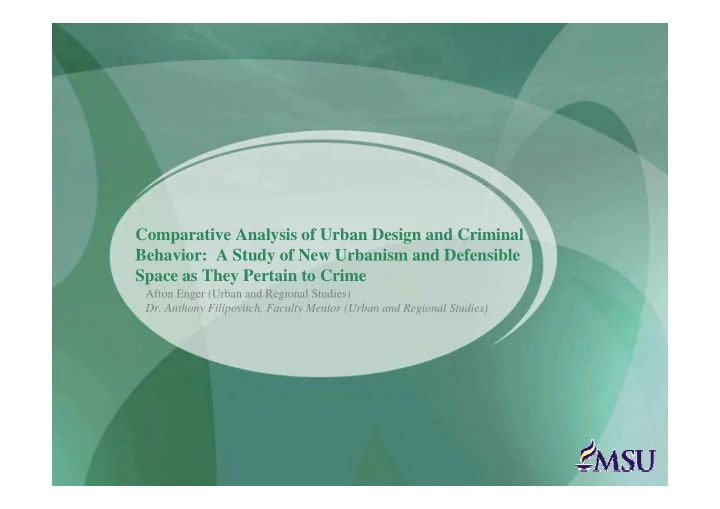

Comparative Analysis of Urban Design and Criminal Behavior: A Study of New Urbanism and Defensible Space as They Pertain to Crime Afton Enger (Urban and Regional Studies) Dr. Anthony Filipovitch, Faculty Mentor (Urban and Regional Studies)
Overview • Goals of research • Urban designs • Research Methods • Results • Future Research • Conclusion
Goals of project • Evaluate criminal behavior in specific urban designs: – New Urbanism – Defensible Space – Vernacular Design To determine whether New Urbanism or Defensible Space is conducive to criminal behavior
New Urbanism Also known as Traditional Neighborhood Design (TND) • Mixed housing • Pedestrian friendly • Accessible to commercial areas
Defensible Space Also described as Crime Prevention Through Environmental Design (CPTED) or Secure By Design (SBD) • Clearly defined personal spaces • Features to visually guide people through spaces • Access control
Vernacular Design • Standard design • Does not share same characteristics as Defensible Space or New Urbanism
Research Methods • Crime rates in 1990 and 2000 collected on 15 of the fastest growing cities in Minnesota – Crime against property – Crime against persons • Urban designs of these cities • Crime rates compared to increase in population using analysis of covariance with SPSS
Results Table 1. Crime Against Property Property Property Property N 2000 1990 Change Vernacular 2.86 1.72 1.15 5 Design Defensible 2.16 1.42 .74 3 Space/New Urbanism New 2.32 1.67 1.21 6 Urbanism ANOVA .036 .090 .812
Results Table 2. Crime Against Persons Person Person Person N 2000 1990 Change Vernacular 9.36 7.9 1.46 5 Design Defensible 4.97 5.0 .03 3 Space/New Urbanism New 5.10 5.27 1.58 6 Urbanism ANOVA .084 .673 .726
Future Research • Use larger sample size • Obtain neighborhood crime statistics • Different types of crime
Conclusion • Findings suggest that New Urbanism is able to influence property crime, but not crimes against persons • In the end it can be said that New Urbanism can keep people from stealing, but not from fighting • More research still needs to be done in this area
References
Recommend
More recommend